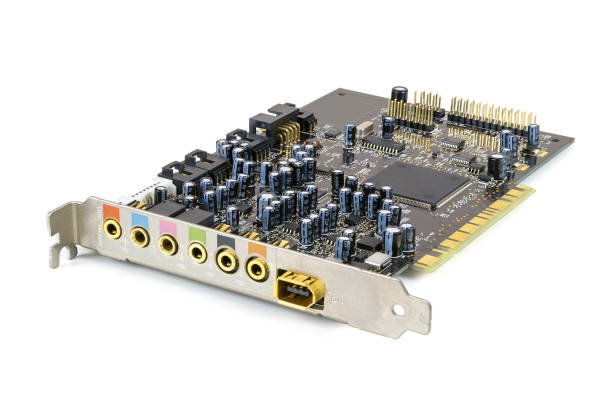What is a sound card and why is it used

What is a sound card and why is it used
Do you know what this sound card is? If not, then today’s article What are sound cards will be very useful for you. In this you will be provided with all the information related to the sound card. This will make it easier for you to understand them correctly, how they work, etc.
By the way, it is also called a sound board or a sound card. A sound card is basically an expansion card or IC that helps in producing sound in any device (computer) and can be heard easily with the help of a speaker or headphones.
Although the computer can work properly even without a sound card, if you install a sound card, the sound quality of your device will be very good. Whereas earlier it had to be installed separately, now it actually comes by being built into the motherboard or in an expansion slot. So far we don’t have any need to install it separately.
By the way, if you want to know more about the types of sound cards and how they work then you should properly read this article about what is a sound card because here I have explained the complete information of this device in a very easy language I have tried. I hope you will definitely like this and all doubts in your mind will also be removed. So let’s move forward without delay.
What is a sound card
A sound card is a component inside a computer. Provides computer audio input and output capabilities. Most sound cards have at least one analog line input and one stereo line output connection.
These connectors are usually 3.5mm mini jacks, which is the size of most headphones we use.
Some sound cards also support digital audio input and output, via a standard TRS connection (tip-ring sleeve) or via an optical audio port, such as a Toslink connector.
Although there are many types of sound cards, it is very important to have a digital-to-analog converter (DAC) in any type that produces an analog output .
They convert the outgoing signal from digital to analog, which can be played with most speaker systems. Require sounds cards that support the input analog also converted an analogue – to – digital (ADC). It digitizes the incoming analog signal, so that the computer can process it.
Where in some computers the sound card is part of the motherboard, while in others it is actually a physical card located in the PCI slot.
If you want more audio capabilities in your computer such as additional input and output channels, you will have to install a new sound card for this. Professional sound cards often support higher sampling rates (eg 192 kHz instead of 44.1 kHz) and have more inputs and outputs.
sound card history
Older computers didn’t have sound cards—they weren’t important to the basic tasks that computers were originally designed for. Instead, earlier devices had basic internal speakers that produced square wave sound.
As computers became more complex and began to enter the consumer market (in the 1980s). Then manufacturers realized that they should consider producing sound in computers, also for advanced applications and general entertainment.
IBM and other manufacturers started turning to audio hardware manufacturers like Adlib and Creative Labs , who were working on the new sound card technology at the time that enabled us to listen to music, sounds, etc. in computers.
By the late 1980s, computers with integrated sound cards appeared on the market. In the early days, these sound cards were mostly focused on a few specific applications. Made specifically for musical composition and speech formation.
At the same time, over time, sound cards gradually became more diverse, they were used in combination with many programs.
What was the first sound card, who made it and where was it used?
Gooch Synthetic Woodwind is the first sound card. It was used by Plato’s stations . It was invented by Sherwin Guch in 1972 . It was a synthesizer capable of synthesizing music with four voices.
The Apple II computer was also capable of using additional sound cards. The Apple Music Synthesizer was the first additional sound card used in the Apple II, produced by ALF Products Inc. It was developed in 1978.
AdLib was the first company make sound cards for IBM computers . AdLib developed the music mixing card in 1987.
How does a computer sound card work?
Audio files in the computer so that everything is stored in the form of an icon. This digital information can easily store many forms of sound waves, but it cannot create sound – these “analog” waves must propagate through the air and only then can they affect something in our ears.
This sound card translates the sound from the digital code into sound waves as you need them.
To do this, the card uses a DAC , or a digital-to-analog converter. The task of this converter is to translate the code of the sound file into electrical impulses that are transmitted through the connections of the sound card to the speakers.
Then the drivers of these headphones convert those electrical impulses into physical sound waves, which then reach your ears in the form of sound. All internal and external speakers must be connected to the sound card correctly , otherwise it will not work properly.
At the same time, sound cards also have a very important function. They have to do the same in reverse.If your computer has a microphone, it will also be connected to your sound card. Here the cards use an ADC , or analog-to-digital converter, which translates the sound waves generated by your voice into code and becomes an audio file.
Sound cards also have additional functionality, such as acting as a MIDI interface for those who want to create a little bit of electronic information.
Existing sound cards are usually very simplified and integrated to keep costs down (while additional features are managed from software drivers), but some versions still have these capabilities built in.
What are voices and channels?
On sound cards you will find both sounds and channels, and there may be some confusion in understanding these two. So let’s understand it properly in easy language.
voices
Sounds refer to the number of independent sounds that come from different sources on a single sound card being managed at the same time.
When your computer plays a tune, but when new mail arrives, a percussion sound is heard, this is the case of two sounds.
Manufacturers always provide sound cards with many sounds for use from both hardware and software sources, because the primary reason for using sound cards is to produce electronic music.
Previous sound cards usually contained only 9 to 18 sounds . While those numbers increased very quickly on an average sound card of about 64 sound , where 32 sound is available from software and 32 sound is available from hardware.
Modern sound cards do not pay much attention to hardware sources, and more emphasis is placed on their software that can produce as many sounds as you want, so today it has become popular to evaluate a sound card by sounds.
channels
Sometimes people use the word ‘ channels ‘ which describes the meaning of ‘voices’.Technically, channels should be used in the traditional sense, since a sound card can handle many audio outputs.
We are now in a familiar situation. Stereo sound has two channels, 2.1 channels stereo allows for one subwoofer, 5.1 channels include surround sound, and 7.1 channels provide the best surround sound.
Most importantly, you need a sound card that supports at least many channels in order for the sound system to be able to pair them.
sound card connections
Here I will tell you about some sound card connections. Where the sound card is are the audio ports or audio jacks on the back of the computer, and their associated colors and connector icons.
digital output (White or Yellow; Words Like: “Digital” or “Digital Out”) – These words are used to surround sound or amplifiers.
Audio in or line (blue; arrows indicate waves) – These are used to connect to external audio sources (eg a tape recorder, record player, or CD player.)
Microphone or microphone (pink) – This connection is a microphone or headphones.
Audio Out or Line Out (green; arrow indicates waves) – This is a basic audio connection for speakers and headphones. This sound card has a second (black) and third (orange) audio output connector.
FireWire – Used in some high-quality sound cards in digital video cameras and in other devices.
MIDI or joystick (15-pin yellow connector) – These were used on earlier sound cards with a MIDI keyboard or joystick.
sound card description
A sound card is a rectangular piece of hardware , with several contacts on the bottom of the card and multiple ports on its side for connecting audio devices, such as speakers.
This sound card is installed in the PCI or PCIe slot of the motherboard.
Because the motherboard, case, and peripheral cards are designed with compatibility in mind, the side of the sound card fits snugly against the back of the case when installed, so that its ports are available. It must be used.
There are also USB sound cards that let you connect headphones, microphones, and even other audio devices to your computer via a small adapter that plugs directly into a USB port .
sound card type
Although there are many types of sound cards, three types are the most important and have their own benefits.
motherboard audio chips
When sound cards were first introduced, these were very expensive add-on cards that cost a lot. But with the advent of computer audio technology, its price has also begun to decline.
Miniaturization technology has allowed computer manufacturers to produce all of these audio-producing technologies on just one chip.
From today on, you may not find a computer that does not have a motherboard sound chip. Motherboard audio chips have helped make sound cards more affordable for all PC owners. If your computer has audio jacks along with other expansion ports on the motherboard’s back such as USB ports, your computer has a motherboard audio chip.
Standard sound cards
A standard sound card is an expansion card that plugs into one of the slots inside the computer.
A great advantage of sound cards over motherboard sound chip is that these sound cards have their own processor chips, while motherboard sound chip must rely on the computer processor to perform any function.
A standard sound card puts very little load on the main processor, which leads to better performance while playing the game.
While some standard sound cards have features you’ll never find on motherboard audio chips, such as 24-bit recording or multi-channel surround sound .
External Audio Adapters
For external audio adapter is a small box that holds all the characteristics of the sound card standard, but it is connected to your computer via USB or FireWire port, not the internal expansion slot.
External audio adapters also have features that standard sound cards don’t, such as auxiliary inputs and outputs, and physical volume control knobs .
The external audio adapter can be moved easily from one computer to another compared to a standard sound card.
How to buy the best sound cards?
When you go to buy a sound card, you should pay more attention to the four basic specifications in total so that you can properly compare one sound card with the other. So let’s talk about these specs:-
Audio Channels Audio channels
correspond to the number of speakers and the number of omnidirectional headphones. The more audio channels there are, the more directions the audio can come from and as a result, it will be more accurate.
This is why two audio channels are quite enough for the average user, while more are needed than only those professionals with advanced speaker/headphone systems.
Bit depth Bit depth
ranges from 8 to 16 to 24. You must have all seen this specification but may not have understood it.
Essentially, bit depth manages the range you hear, and 24-bit audio depth is the most accurate out there. It benefits you by getting a higher bit depth when there’s low quality audio as well, reducing floor and ceiling noise.
Basically, the lower your binary depth, the more difficult it is to separate it from the louder. 16 is the lowest, and 24 is the highest end.
SNR
The full form of SNR is the sound-to-noise ratio . Have you ever plugged your speakers in and turned them on, you might hear a buzzing sound. This sizzling sound is the noise in SNR. The higher the SNR, the quieter the background noise.
Sample rate Sample rate
is measured in kilohertz and ranges from 44.1 to 192. Some audiophiles think higher numbers are better, but if you don’t have world-class hearing equipment, you won’t realize the difference between them in most cases.
44/48 kHz is a record, but if you’re using a high-end audio device, you can also increase the sample rate.
What are common problems with sound cards? How do we solve it?
“The sound is not coming on my computer “
This situation must have happened to all of us at one point or another. It’s possible that the sound card or speakers/headphones have been disconnected from their ports/power and no longer communicate with each other, or it may be related to the software that allows the audio to play. stop for.
In this, you first need to find out if the audio of the video, audio or movie is not muted , or if the sound of your system is not muted. Because it is normal for this to happen.
Besides, it may also happen that the sound card itself is disabled in the device manager. So these things should be given some attention.
Another reason for not getting sound is because your device driver itself has become corrupt. In such a case, you should download and install all sound card drivers from the Internet.
If your sound isn’t coming in even after checking the things above, you probably don’t have the right media playback software installed.
In all these things, you will surely get a solution to your problem.
Can sound cards be upgraded?
A large sound card can easily be replaced with a better quality sound card. So if you want to upgrade your sound card, you can definitely do so.
While the motherboard’s built-in audio hardware cannot be replaced , it can be disabled, so you can switch to a better PCI sound card .
With advanced sound cards, you can enhance the sound, adding more clarity to digital audio, or use processing power to reduce CPU load.
There are also external sound cards connected via a USB port for more active sound management. If you wish, you can buy both the internal sound cards and the peripheral versions, as long as they are compatible with your computer.
If we talk about the price of the boom of these sound cards, then they are quite expensive, while their basic models are quite enough for most people. The rest you can buy as per your budget.
What are the benefits of a sound card?
Apart from enhancing the sound quality, sound cards also have many different benefits. Let’s move on to them.
1. Support more audio channels. 5.1 and 7.1 channel audio provide more ports, better surround speaker systems, and directional sound in headphones.
2. It provides more audio ports in the system . that did not exist in the previous system.
3. On some older systems/CPUs, the sound cards also carry some load from the CPU on themselves, which wouldn’t put a load on the CPU to handle the audio processing and would have done it themselves. Whereas in modern devices today it is also difficult to notice this difference.
4. This shields from any electrical interference.
Many high-end sound cards already provide shielding to prevent electrical interference from other components.
5. Provides more accurate bass, vocals and directional sound.
If you’re using an onboard low frequency audio chip, and then switch to a sound card, you’ll see the difference between these two pretty well. Because on the sound card you will hear more clear bass, bass and sound.
What did you learn today
I hope you liked my article What is a sound card . I’ve always been trying to give my readers complete information about why to use a sound card, so that they don’t have to search other sites or the internet in the context of that article. This will also save their time and they will also have all the information in one place.
If you have any doubts about this article or if you want there to be some improvement in it, you can write low comments on it.
If you liked this post What is Hindi Language Sound Card or learned something, please share this post on social networks like Facebook, Twitter, etc.



